The sleek exterior and OS of the Mac has long been associated with the creative world, whether it's music production, graphic design, or filmmaking. And while PCs are narrowing the gap in terms of reliability and functionality, when it comes to making music the Mac is still considered a thoroughbred machine.
Part of this is the plug-and-play aspect of these machines. Mac users don't have to worry about components inside the box not talking to each other. Everything just works. So you can spend less time researching which graphics card works best with which motherboard, and more time focusing on your music.
And if you're making music, you'll need a way to get sound in and out of your computer without sacrificing any quality. Enter the audio interface.
The what now?
What Is An Audio Interface For Mac?
Put simply, an audio interface for mac (or indeed for PC) is a device that plugs into your computer and enables you to get sound in and out of it. Audio interfaces connect via USB, Thunderbolt, and (if you're living in the past) Firewire. Some have multiple connectivity options allowing for more flexibility.
For a more detailed guide on audio interfaces check out this article. But read that later. You want to know more about audio interfaces for Mac, right?
All Mac computers come with a sort-of audio interface, in the form of a sound card. That's how you hear the weird frog sound when you get notifications or talk to people on Zoom calls (other video conferencing is available).
The input and output quality on these built-in sound cards is not great though. It's fine if you're checking out your Discover Weekly on a Monday morning, but not what you want when you're trying to capture that delicious acoustic guitar passage you've just written.
But Do I Really Need An Audio Interface?
OK, so maybe you're not recording acoustic guitar. Or vocals. Or anything. You're a sample-master and everything is produced 'inside the box'. Cool. You could just plug your 'phones in to the built-in headphone output found on all mac computers, and you're away!
But if you want the best for your music (and why wouldn't you, you crazy bear!) you'll want to hear it at its full sonic potential. You can't plug your trusted nearfield monitors into a sound card.
And what happens when you decide you do actually want to lay down some vocals? Or plug in your midi keyboard? Or take your music into the live arena, a la Deadmau5?
For all this, and a whole lot more, you'll need an external audio interface.
OK, What Is The Best Audio Interface For Mac Computers?
Steady on, cowboy! There's a whole bunch of considerations to take into account when choosing an audio interface. But for the impatient reader, here's a quick rundown of the best audio interfaces for mac users:
- Presonus Audiobox USB 96 ($100)
- Focusrite Scarlett Solo 3rd Gen USB Audio Interface ($120)
- MOTU M2 2x2 USB-C Audio Interface ($200)
- M-Audio AIR 192|8 USB Audio Interface ($240)
- Solid State Logic SSL2 2x2 USB Audio Interface ($270)
- iConnectivity AUDIO4c Dual USB-C Audio and MIDI Interface ($400)
- Universal Audio Apollo Twin X Duo ($1200)
- Steinberg AXR4T 28x24 Thunderbolt ($2500)
- Universal Audio Apollo x8 Heritage Edition 16 x 22 Thunderbolt 3 Audio Interface ($3800)
- Avid Pro Tools Carbon ($4000)
(Note that all prices are approximate, and may vary between retailers).
So Many! How Do I Choose An Audio Interface?
Which interface for mac you choose depends on a lot of factors, not just the kind of music you're producing. First and foremost let's talk about money, honey.
Budget
Don't get yourself into financial difficulties when buying gear. Any gear, not just audio interfaces. While there is some sense in future-proofing your purchase to allow for growth, you won't be making the best music if you're stressed out over money.
So decide in advance what your budget is going to be when shopping for an audio interface. There's so many makes and models on the market you'll have plenty of options to choose from, no matter what your requirements are. And you can always upgrade your gear as you go.
Other Considerations
Okay, daddy finance has had his say. Now on to the nuts and bolts. What else do you need to look for in an interface?
I've covered this in detail in a different article, but a quick refresher of things you'll need to think about when choosing an audio interface include:
- Number of inputs/outputs
- Headphone outputs
- Connectivity
- Sound quality and sample rates
- Mic preamps
- MIDI connectivity
- Portability
- Included software bundles
The 10 Best Audio Interfaces For Mac
1. MOTU M2 2x2 USB-C Audio Interface

This USB audio interface from Mark Of The Unicorn offers high quality sound quality at a price even the most budget-conscious musician can afford. Designed with portability in mind, this bus-powered interface for mac offers everything the solo musician or producer needs to make music in the studio or on the move.
Most of the tools you need frequent access to sit on the front of the unit. Two inputs can handle lines or mics, and the phantom power switch for each is easily accessible next to the inputs. Zero latency monitoring can be accessed by the one-touch button, also located on the front panel.
The color LED metering display enables the user to easily monitor levels going in and coming out of the box, a feature that isn't present on all audio interfaces.
Around the back of the box are two analog monitor outputs - available as line and RCA - along with handy MIDI connectivity.
The bundled software includes 6 GB of loops and sounds, and Ableton Live Lite.
Notable Features
- Loopback functionality for live streaming and podcasting
- Zero latency monitoring
- Sturdy and portable, for the roaming musician or podcaster
- Includes MIDI interface
- Only two inputs
My Verdict
If you're looking to buy your first audio interface you could do a lot worse than the MOTU M2 USBC. It's got everything you need to start making music right out of the box, and would function well in your studio or on the road.
2. Focusrite Scarlett Solo 3rd Gen USB Audio Interface
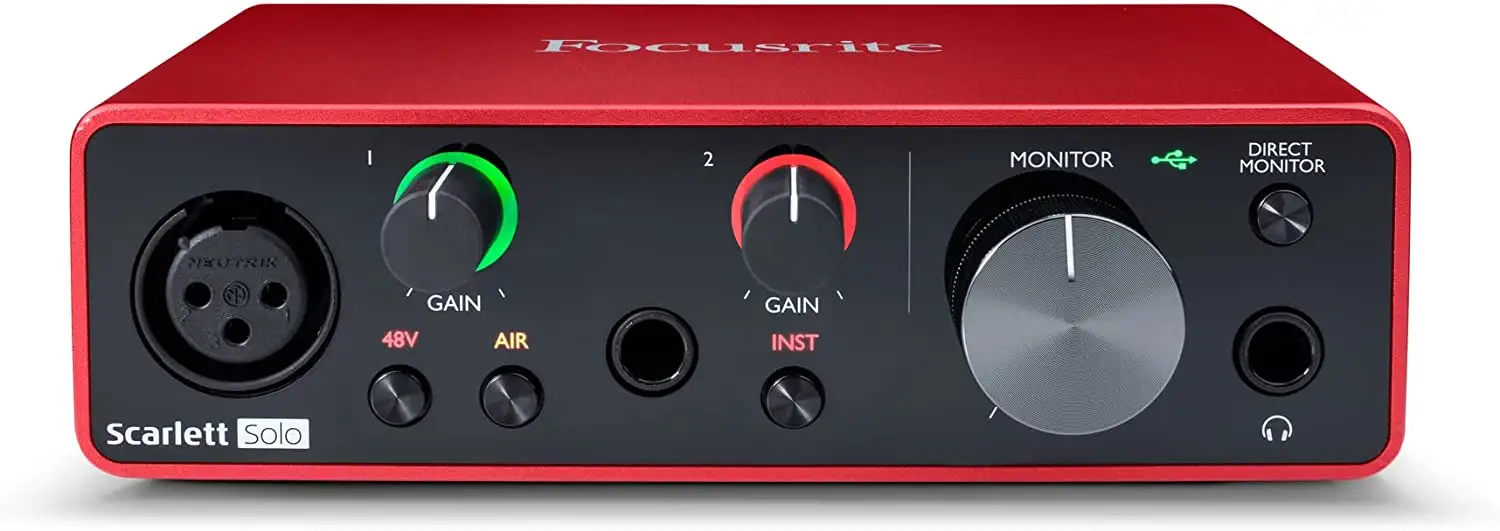
This USB audio interface from Focusrite is designed for the solo artist or musician. Its sound quality and affordability make it a popular choice among the many usb audio interfaces available for this corner of the market.
The inputs come in the form of an XLR, and a Hi-Z line input, both with preamps. The award-winning Focusrite mic preamp comes with a switchable air mode to give your recordings a brighter, more open sound.
Monitoring is made simple, with the 'halo' indicators around each input, giving you a color coded indication of when your signal is too hot, and a large volume knob to control the output. There's one headphone output on the front panel, and two line outputs around the back, along with the USB C port.
Notable Features
- Air mode
- Ideal for the solo artist
My Verdict
All in all this is a tidy, and affordable, little machine for anyone just starting out and needing a new audio interface.
3. M-Audio AIR 192|8 USB Audio Interface
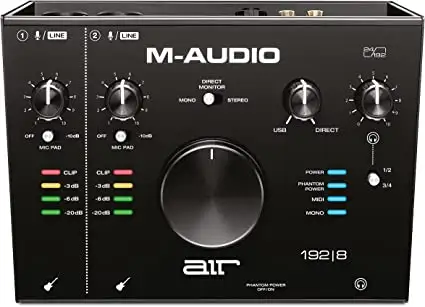
M-Audio are well-known for making midi controllers, but a lesser known side of their business is the line of audio interfaces they manufacture.
Who knew?
The AIR 192|8 gives users professional quality sound at a budget-friendly price. Deriving its name from the maximum sample rate the unit records at and the number of inputs is a tad misleading. While the unit does record at up to 24-bit/192kHz it only has two simultaneous recording inputs, albeit with flexible options. But hey-ho. Let's look at what it has to offer the budding producer.
There's two mic/line combo inputs, each with a -10dB pad switch, and a further two hi-z instrument inputs - ideal for recording guitar or bass plugged directly into the unit. Phantom power, activated via a switch on the front panel, means you can make use of condenser mics in your recording shenanigans.
MIDI in/out connectivity is provided via two 1/8" connections around the back of the unit. To hook up your midi controller you'll need to use the two 5-pin MIDI to 1/8 inch adapters that are included in the box.
Around the back of the unit is where all the output action happens - no surprises there. Two dedicated TRS speaker outputs are complimented by RCA outputs, with an additional pair of auxiliary stereo outputs.
Dealing with latency while monitoring is easy, with the USB/Direct balance knob on the top panel. There's also a switch to allow you to flip between two different audio streams while listening on the headphone output.
Notable Features
- Two hi-Z instrument inputs
- USB/Direct knob for mixing and monitoring
- MIDI connectivity
- Rugged metal chassis ideal for location recording
- Additional output options
- Limited inputs
My Verdict
While this audio interface is decent enough I think there's better options at this price range.
4. Presonus Audiobox USB 96

The Audiobox USB 96 is proof that you can get a decent audio interface for mac without breaking the bank.
This fully USB powered interface records at up to 24-bit/96kHz through the combo inputs. The high quality mic preamps guarantee audio quality won't suffer, and the onboard phantom power means you can use your favorite condenser mic to record.
A mix control knob allows you to adjust the balance between input signal and playback, so latency won't be an issue when you're laying down tracks.
And despite the compact size the Audiobox includes a standard I/O MIDI interface, so you can plug in your favorite synth or midi controller.
The heavy duty steel chassis is ideal for engineers who take their rig out and about and don't want to worry about damage, while the powerful output for headphones means you'll be able to hear your work even if you're mixing at Kings Cross train station.
Finally it's worth mentioning that the bundled software includes the Presonus Studio One Artist DAW, as well as a bunch of third party plug ins. For about a Benjamin the novice mac producer can get kitted up with everything they need for music production on the go.
Notable Features
- MIDI I/O
- Budget friendly
My Verdict
This entry-level unit from Presonus is a good audio interface for creative artists at the beginning of their journey.
5. Solid State Logic SSL2 2x2 USB Audio Interface
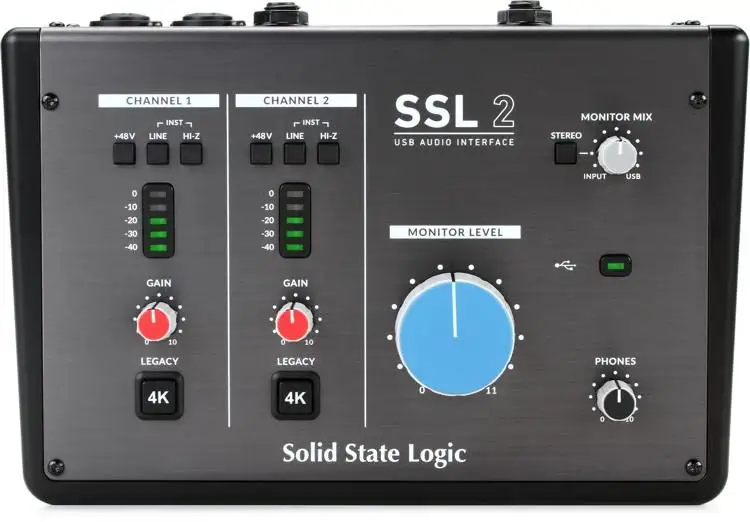
If you're hunting for a portable audio interface at the lower end of the market but don't want to compromise on sound quality the SSL2 could be just the ticket for your musical adventures. For less than three Benjamins you can have the iconic SSL sound in your home studio.
All the action happens on the top panel of the interface. Input gain controls, phantom power switches, level controls for the monitor outputs and headphones, and a handy monitor mix dial to balance between input signal and playback.
And don't forget to make use of the the magic 'Legacy' button to bring the sound of the famous SSL 4000 console to your recordings. That classic analog sound at the touch of a button!
The rear of the unit is the business end (ahem). Two balanced neutrik combo inputs, two analog line outputs, headphone jack, and USB-C port. There's no need for a separate power supply for this bad boy - he draws his juice from the included USB cable, making him an ideal buddy for road trip recordings.
The bundled software is also a major plus-point with this audio interface. In addition to third party software from the likes of Avid and Ableton you also get two SSL Native channel strips.
Notable Features
- 'Legacy' button for vintage warmth
- Solid, sturdy and portable
My Verdict
While not the cheapest model on the market this is a great choice for the solo musician looking for the best audio interface for mac.
6. iConnectivity AUDIO4c Dual USB-C Audio and MIDI Interface

From the outside the iConnectivity AUDIO4c looks like a regular four-channel audio interface.
Along the front, four line and mic inputs sit next to an LED display, followed by a control knob. Fair enough. Around the back you'll find the analog line outputs, traditional 5-pin MIDI ports, and a headphone jack.
But there's more to this little powerhouse than meets the eye.
Let's start with the USB connector situation. The AUDIO 4c gives you multiple options: 2 USB-C, and a type A. So, if you're running out of USB ports on your laptop you can plug in your usb powered midi interface directly to the interface to free up a port.
Want to make use of the MiniMoog model D synth app you have sitting around on your phone? Connect your phone to one of the USB-C ports and you'll have midi and audio data flowing between your DAW and your phone effortlessly. You can use any USB class compliant midi external devices this way.
If you're wondering where the dials are to set input or headphone levels you'll be surprised to learn that the front panel responds to capacitive touch. While the lack of tactile turning may feel a little weird at first, it does reduce the risk of accidentally knocking settings out of place.
And that's not all. The control software that comes with the interface allows the user to easily route audio and MIDI to and from any device connected to the unit. Add to this the filtering and remapping capabilities, and you have an unholy amount of control over things.
Notable Features
- Auracle control software unlocks complex MIDI routing, filtering, and remapping
- Standalone MIDI operation means this is ideal for live performances and streaming
- Massive routing power
- Multiple connectivity options
- You can use it without a computer
My Verdict
For mac producers wanting extreme MIDI connectivity, the iConnectivity AUDIO4c is a perfect choice of audio interface.
7. Steinberg AXR4T 28x24 Thunderbolt Audio Interface

We're heading into the higher end of the market now - brace yourselves! Audio equipment in this range is geared more towards the serious producer or studio, rather than singer-songwriters recording at home. This audio interface from Steinberg is no exception, with its extensive connectivity options and excellent sound fidelity.
With four mic/line inputs, eight analog line inputs, and additional digital connections, you won't run out of options when recording larger ensembles. The included matrix mixer software makes the management of this multitude of inputs easy. If you need more inputs you have the option to daisy chain three AXRT4s together via the Thunderbolt 2 connections, to give you a humongous eighty-four inputs.
Onboard DSP processing from Yamaha means you can monitor you performance as you record without latency getting in the way. You can also harness these effects when at the mixing stage without worrying about your computer falling over from all the processing work.
The mic preamps are a hybrid design developed by Yamaha that can utilize the onboard SILK processing - an emulation of the classic Neve console sound of the 70s. Yes folks, now you can take your analog signal and give it a seductive touch of natural compression and saturation just like Queen and David Bowie did.
Eight line outputs and two headphone outputs gives you plenty of monitoring capabilities, as well as the option to use external effect processing. Finally, Cubase AI is included with the unit so you can take advantage of the 32-bit integer converters and capture the best audio you can.
Notable Features
- Daisy chain up to three units together
- 32-bit/384kHz recording capability
- Latency free DSP-powered monitoring
- Get that Neve sound
My Verdict
When you compare the price and the features, for what you get the AXRT4 is one of the best audio interfaces for Mac.
8. Universal Audio Apollo x8 Heritage Edition 16 x 22
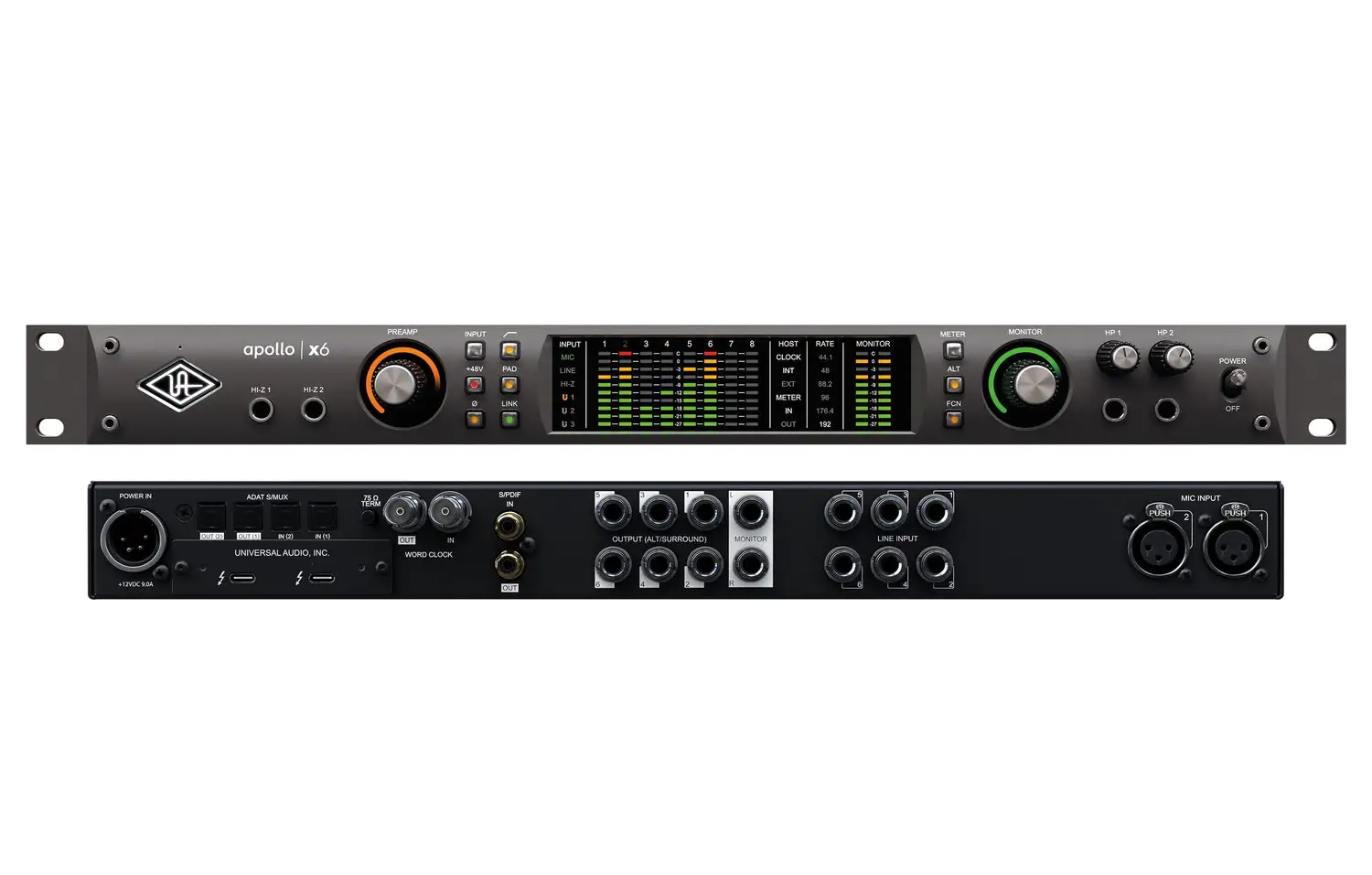
Universal Audio is an oft-heard name in professional studios around the world. If you hook this monster up to your mac you'll be guaranteed to sound great and achieve super human productivity.
This Thunderbolt audio interface gives you unrivaled low latency, and massive bandwidth for producers tacking multiple instruments at the same time. Built for Thunderbolt 3 macs, it's backwards compatible with Thunderbolt 1 and 2 macs, although the adapter is sold separately.
The unit boasts eight Unison mic preamps, giving your recordings stellar sound quality. As if that wasn't enough you can use any of the three included plug-ins to re-create the sound of classic pre amps on your recordings to give them a natural analog warmth.
Six DSP cores mean you can track your recordings whilst monitoring the effects in real without suffering any performance issues. (From the computer - I can't guarantee it'll make your drummer play in time). The powerful HEXA Core processors also let you run huge numbers of UAD plug in counts while mixing in your DAW.
The built-in talkback mic is a nice addition, making it easy to talk to musicians (relatively speaking - we are an odd bunch after all), and is useful for slating takes, so you you still know what's happening at take 70.
Finally, the included software is pretty special. This isn't your average add-on bundle. In addition to the pre amp plug ins mentioned above you'll pick up a whole bunch of other Universal Audio software, including EQs, compressors, reverbs, and tape emulation technology.
Notable Features
- 16/22 simultaneous inputs/outputs
- Onboard DSP processing
- 7.1 Surround Sound monitoring support
- Dual headphone outputs
- Optical Toslink digital connectivity
- External 12V DC power supply included
- Excellent sound quality and software bundle
My Verdict
While the price tag is steep, if you've got the cash to invest in your business this audio interface is perfect for a producer setting up a project studio. The included software means you can hit the ground running as soon as you open the box and book a band.
9. Universal Audio Apollo Twin X Duo Heritage Edition
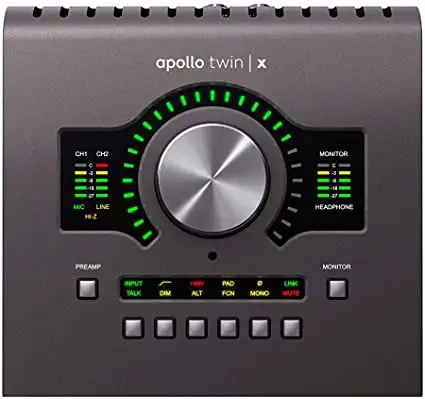
If you want the Universal Audio name in your studio, but don't want to splash out for the full Apollo, check out its little brother, the Universal Audio Apollo Twin.
This thunderbolt audio interface ships with some of the same software as the Apollo X8 so you get the benefit of vintage preamp emulation, and other software to recreate that classic analog sound. Track in realtime with the two onboard DUO core processors, and never run out of CPU power again!
The unit has three analog inputs; 2 mic/line combos around the back, and a 1/4" Hi-Z handily located on the front. Around the back there's also two 1/4" monitor outputs, and two further line outputs for additional preamps or monitoring options.
A single Optical Toslink digital input boosts the total simultaneous inputs you can use to ten. Additional Apollo interfaces can be networked through the Thunderbolt connection to increase your input count and DSP power. This is only really useful if you have spare Apollos lying around. With the cost-per-input ratio you'd be better off trading up to an audio interface with more inputs.
Notable Features
- 127dB dynamic range
- Fast Thunderbolt connectivity
- Phantom power
- Excellent sound quality
- Realtime tracking with analog emulation software
My Verdict
If you're looking for a sturdy, reliable audio interface the Universal Audio Apollo Twin could be the audio interface for you.
10. Avid Pro Tools Carbon

We are firmly in territory that is not for the faint of heart; brace your credit cards as we explore the Carbon - a professional audio interface, if ever there was one.
This hybrid production system from Avid combines an audio interface with Pro Tools recording software and while it's one of the more expensive audio interfaces on the market, if you're a serious recording studio this is worth looking at.
This rackmount audio interface connects to your mac via an ethernet cable. This, coupled with the external power supply, means the Carbon gives you phenomenal sound quality with exceptionally low latency.
The eight HDX DSP cores will have you running more plug ins than if you were relying on computer resources alone. The unit comes bundled with a whole bunch of AAX software, plus instruments from UVI, Native Instruments, and hardware emulations from leaders in the marketplace, so you'll have no shortage of ways to try this out.
There's a flexible number of in/out options for tracking. For smaller ensembles and overdubs there's eight combo mic/line inputs. If you need to biggify your recording power you can utilize the ADAT digital inputs/outputs (there's two) to expand your studio. It's also worth noting here that, unlike most audio interfaces for mac, the Carbon has a whopping four headphone jacks.
With so many features I could rattle on all day. Suffice to say this is an excellent audio interface.
Notable Features
- Rackmount unit
- Eight HDX DSP cores
- 115 AAX Plugins included
- AD/DA converters and preamps ensure exceptional audio quality
- It's the ultimate set-up for recording live instruments with the best quality sound.
My Verdict
If you're a Pro Tools head, and are committed to being one for the foreseeable future, this audio interface for mac is going to supercharge your workflow and creativity. If you're a user of another DAW there's other options on the market that will serve you better.
Conclusion
This is where I'll write my conclusion. As you can see, there's a lot of great audio interfaces out there that will get sound in and out of your mac. Whether you need usb connectivity, or prefer to use a Thunderbolt connection for even swifter data transfer there's an option for you. Go forth and record, bold producer!





